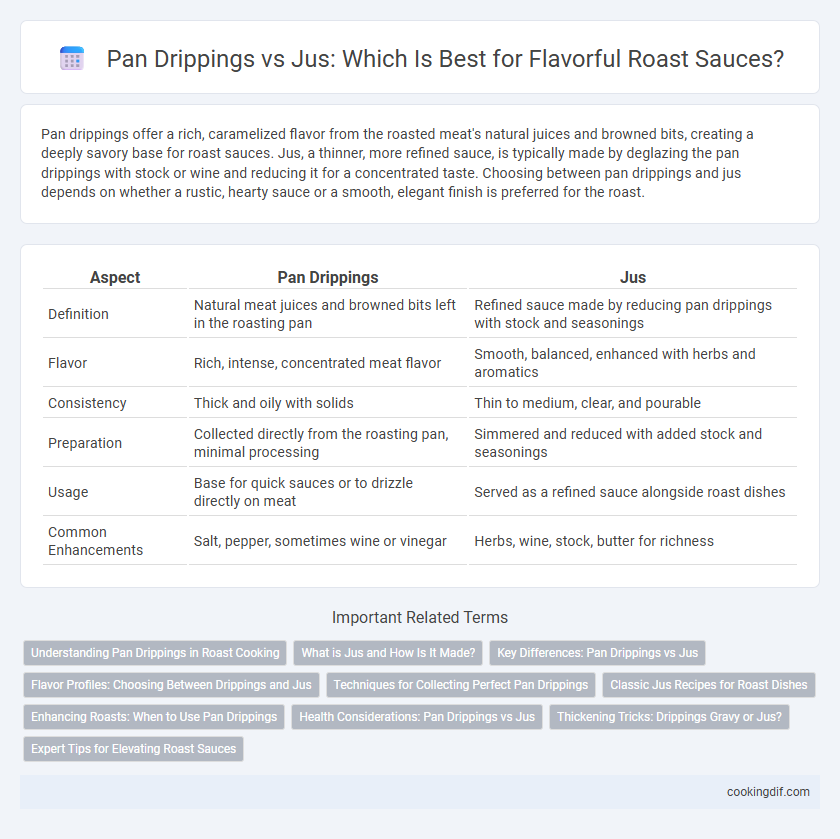Pan drippings offer a rich, caramelized flavor from the roasted meat's natural juices and browned bits, creating a deeply savory base for roast sauces. Jus, a thinner, more refined sauce, is typically made by deglazing the pan drippings with stock or wine and reducing it for a concentrated taste. Choosing between pan drippings and jus depends on whether a rustic, hearty sauce or a smooth, elegant finish is preferred for the roast.
Table of Comparison
| Aspect | Pan Drippings | Jus |
|---|---|---|
| Definition | Natural meat juices and browned bits left in the roasting pan | Refined sauce made by reducing pan drippings with stock and seasonings |
| Flavor | Rich, intense, concentrated meat flavor | Smooth, balanced, enhanced with herbs and aromatics |
| Consistency | Thick and oily with solids | Thin to medium, clear, and pourable |
| Preparation | Collected directly from the roasting pan, minimal processing | Simmered and reduced with added stock and seasonings |
| Usage | Base for quick sauces or to drizzle directly on meat | Served as a refined sauce alongside roast dishes |
| Common Enhancements | Salt, pepper, sometimes wine or vinegar | Herbs, wine, stock, butter for richness |
Understanding Pan Drippings in Roast Cooking
Pan drippings, the concentrated flavorful juices collected from roasting meat, serve as the foundational element for creating rich and savory roast sauces. These drippings contain caramelized fats, rendered juices, and browned bits known as fond, which contribute deep umami and complexity to the sauce. Properly deglazing the roasting pan with stock or wine captures these concentrated flavors, transforming simple pan drippings into an enhanced jus that elevates the overall roast experience.
What is Jus and How Is It Made?
Jus is a concentrated, flavorful sauce made by deglazing the pan drippings from roasted meat with stock or wine and then reducing the liquid to intensify the taste. Unlike thickened gravy, jus remains thin and glossy, highlighting the natural juices and caramelized bits left in the roasting pan. This technique captures the essence of the roast, creating a rich and aromatic complement to the dish.
Key Differences: Pan Drippings vs Jus
Pan drippings contain caramelized bits of meat, fat, and juices left in the roasting pan, offering a rich, concentrated flavor and thicker texture ideal for gravies. Jus is a light, flavorful sauce made by deglazing the pan drippings with stock or wine and reducing it to a thinner consistency, providing a more refined and delicate accompaniment to roast. The key difference lies in texture and intensity: pan drippings are robust and hearty, while jus delivers a subtle, elegant taste with less fat.
Flavor Profiles: Choosing Between Drippings and Jus
Pan drippings offer a rich, concentrated flavor with caramelized bits and a glossy texture that enhances the roast's natural taste. Jus, made by deglazing the pan with stock and reducing it, provides a lighter, more refined sauce with a balanced, savory profile. Selecting between pan drippings and jus depends on whether a robust, intense flavor or a smooth, elegant finish best suits the roast dish.
Techniques for Collecting Perfect Pan Drippings
Collecting perfect pan drippings for roast sauces involves careful control of roasting temperature and resting time to concentrate flavors without burning the fond. Using a roasting pan with a rack allows fat to drip away from the meat, preserving the flavorful browned bits essential for jus. Deglazing the pan immediately after roasting with stock or wine captures these concentrated drippings, creating a rich base for both pan sauces and jus.
Classic Jus Recipes for Roast Dishes
Classic jus recipes for roast dishes emphasize the rich, concentrated flavors extracted from pan drippings, enhanced by careful deglazing with wine or stock. Pan drippings form the essential base, providing natural caramelized juices that intensify the roast's savory depth. Using jus instead of heavier gravies results in a lighter, more refined sauce that highlights the meat's natural taste and texture.
Enhancing Roasts: When to Use Pan Drippings
Pan drippings contain concentrated flavors and caramelized bits from roasting meat, making them ideal for creating rich, savory roast sauces that deepen the overall taste. Use pan drippings when aiming to enhance roasts with intense, natural meat flavors and when a thicker, more robust sauce is preferred. These drippings are perfect for gravies and sauces where the deep, browned essence of the roast is key to complementing the dish.
Health Considerations: Pan Drippings vs Jus
Pan drippings contain concentrated fats and calories from roasted meat, which can increase saturated fat intake and impact heart health. Jus, a lighter and often strained sauce made from reduced broth or stock, typically has lower fat content and fewer calories, making it a healthier option for roast sauces. Choosing jus over pan drippings can support better cholesterol management and reduced risk of cardiovascular disease.
Thickening Tricks: Drippings Gravy or Jus?
Pan drippings contain rendered fat and caramelized bits that create a rich base for thickened gravy, often enhanced by flour or cornstarch to achieve a luscious texture. Jus, in contrast, is a more refined, thinner sauce made by simmering meat juices and stock without thickening agents, preserving a delicate and concentrated flavor. Thickening pan drippings results in a hearty gravy ideal for gravy lovers, while jus offers a lighter, elegant finish for roast dishes.
Expert Tips for Elevating Roast Sauces
Pan drippings contain concentrated flavors and caramelized bits essential for creating rich roast sauces, while jus offers a lighter, more refined finish ideal for delicate meats. Experts recommend deglazing pan drippings with wine or broth to balance intensity and enhance complexity, then reducing slowly for a glossy texture. Incorporating fresh herbs like rosemary or thyme and finishing with a splash of acid, such as lemon juice or vinegar, elevates the sauce's depth and brightness.
Pan Drippings vs Jus for Roast Sauces Infographic

 cookingdif.com
cookingdif.com